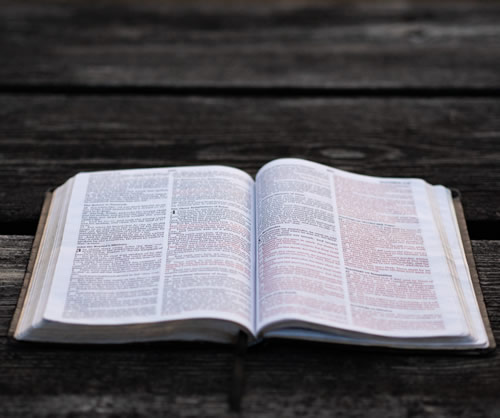The Gospel According To John
We launched Reading The Bible Together in October 2018. It is a way for the whole church community to read through the same book(s) of the Bible at the same time. It also forms the content for our Home Groups which meet on the second and fourth Wednesdays’ of each month. Each time we will meet to discuss what we have read, what we have learned and any questions we have.
We will be reading The Gospel of John together during February. Take your time, go at your own speed and begin in chapter 1 and keep reading through. As you do, ask the Lord to make clear to you what He is saying through His Word. Write down anything that strikes you, puzzles you, or encourages you.
Who wrote it?
The book itself is anonymous, the writer doesn’t disclose himself. However it is fairly safe to assume it is the Apostle John, the Son of Zebedee. There is evidence for this in the book itself and also very early on in Church history the book was attributed to John.
What is it about?
John is one of the four Gospels. Gospel means good news. The Gospels (Matthew, Mark, Luke & John) are accounts of Jesus’ life, death, and resurrection. Sometimes they are referred to as biographies of Jesus in a sense this is correct but in another sense they are very unlike any other biographies. These four accounts pay very little attention to the majority of the life of Jesus, instead they all focus on the last three years of his life. This is their focus because this period of public ministry (Jesus’s teaching, preaching & healing) culminating in his death and resurrection is the foundation for the message of the Gospel. Each of these books is recording the life of Jesus that people would know him, and put their confidence in him. John says himself ‘But these are written that you may believe that Jesus is the Messiah, the Son of God, and that by believing you may have life in his name.’ John 20:31.
Although John is one of four Gospel writers, his Gospel is most unique. The other three (Matthew, Mark, Luke) are very similar, while John approaches his task quite differently.
What to look out for?
See The Signs: John uses the language of signs when describing the miracles of Jesus. These signs are significant in the structure of the book. There are seven signs in the fist half of the book up to chapter 12 which acts as a transition – Jesus hour has now come. Then John’s focus is on the final sign the Resurrection. (Some count six signs in the first half of the book and see the Resurrection as the seventh- it depends if you count the walking on water in Ch.6 ) Numbers aside what is key is that each of these signs is pointing to something in the life and ministry of Jesus. It demands a response, they are not ends in themselves.
Hear The Sayings: Alongside these signs are sayings. Seven ‘I Am’ sayings which the book is famous for. Jesus, by using this language is pointing to his divine nature (that he is God) and also to his divine purpose (what he has come to do).
Consider the Controversy: Notice how often in the book John pays attention to Jewish rites, feasts and traditions; Passover, Feast of Tabernacles, Jars of Water for Purification, Temple. John clearly want us to see Jesus as the fulfillment of all of the Old Testament elements. On top of that they are often used by John to show the opposition Jesus’ receives from Jewish leaders, they are points of controversy in Christs’ ministry.
Glory in the God Man: In John’s gospel we clearly see the two natures of Christ. We see that he is fully God and Fully Man. In the Prologue (1:1-18) we hear he is the Word ‘the Word was with God, the Word was God’, also the I Am saying and the amount of times Jesus simply uses the name I Am in the book, this is God’s name that he had given to his people. Jesus himself says ‘if you have seen me you have seen the Father’ (John 14:9). But we also see the humanity of Christ. It is in John’s gospel we read that ‘the word became flesh and dwelt among us’ (John 1:14) and that Jesus Wept (11:35) and experienced thirst (John 19:28). We are reminded that in the Person of Christ these two natures were perfectly united, that he could be our sin bearer and be a spotless sacrifice.
Bay Church Reflections
Each month we will look to refer to the book of John as often as possible. Increasing our familiarity with the book and providing more opportunity to learn from it. As they happen this page will be updated.
- Introductory Sermons –
- Home Groups February 12th & 26th
- Prayer Meeting February 6th, 20th
- Children’s Address during Morning Meeting – I Am Sayings
Introductory Sermon
John’s Message – John 20:31 – Morning
John’s Method – John 2:1-12 – Evening
Questions
If you have any questions about the book of John as you read please contact Andrew: andrew@thebaychurch.org.uk
Resources
Want to go a bit deeper? You may find these resources helpful in your understanding of John’s Gospel.
The Bible Project have two excellent videos on John’s Gospel – https://thebibleproject.com/explore/john/
D.A. Carson, The Gospel According To John, Pillar (IVP, 1991)
Bruce Milne, The Message of John, BST (IVP, 1993)
FF, Bruce, The Gospel of John, (Eerdmans, 1993)
Leon Morris, The Gospel According To John, NICNT (Eedrmans, 1971)





